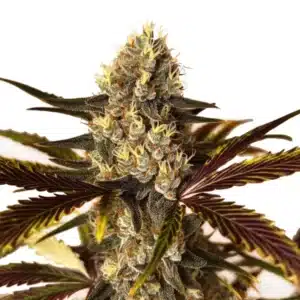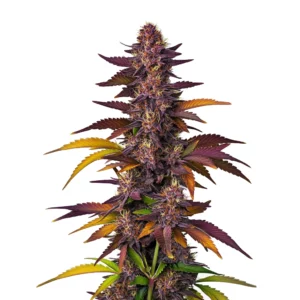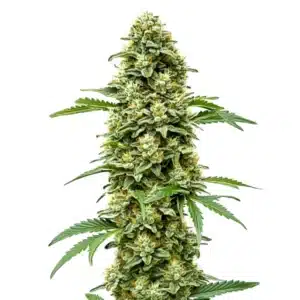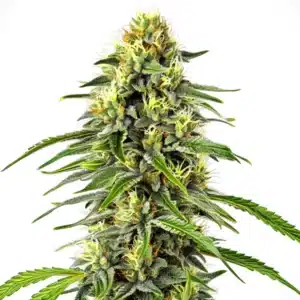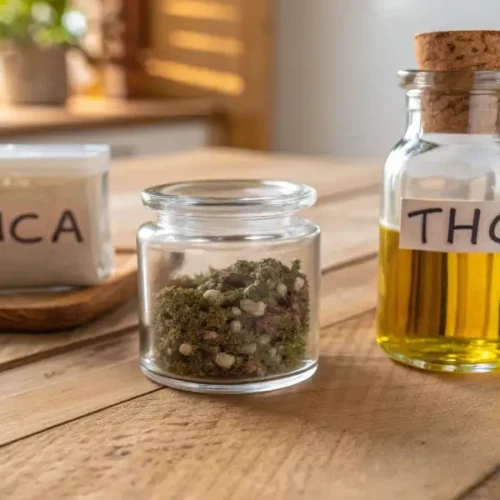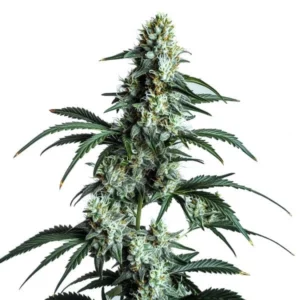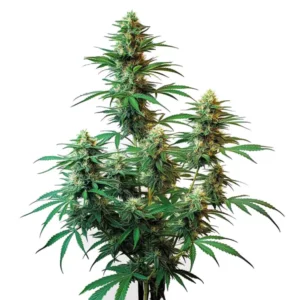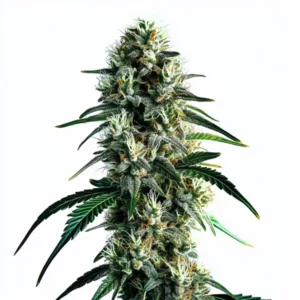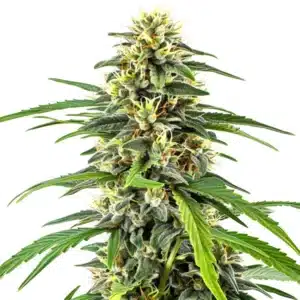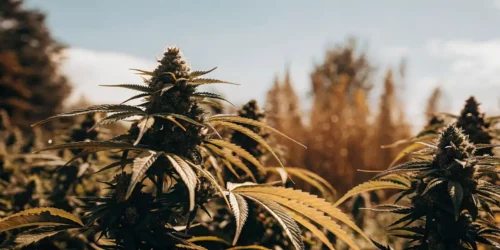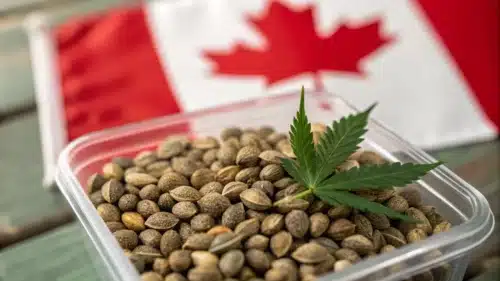From Blimburn Seeds, we bring you the best tips and tricks. Also, we are committed to all growers in the world to maximize their outdoor growing production. Whether you’re cultivating your favorite strain or growing Sour Diesel outdoors, our guidance will make you an expert grower and lover of our seeds.
Growing Sour Diesel Outdoors in Canada
Sour Diesel is a beloved cannabis strain known for its potent effects and distinct aroma. However, growing Sour Diesel outdoors in Canada presents unique challenges and opportunities. The Canadian climate, with its varying regions and short summers, requires careful planning and adaptability. This article will guide you through each step, from selecting the right spot to managing the unpredictable weather. Whether you’re a beginner or an experienced grower, learning how to grow Sour Diesel outdoors in Canada will help you achieve impressive yields.
Recommended Strains
Sour Diesel
 THC: 22 - 25%
THC: 22 - 25% Type of seed: Feminized
Type of seed: Feminized Phenotype: Mostly Sativa
Phenotype: Mostly Sativa Day to flower: 8 - 10 weeks
Day to flower: 8 - 10 weeks
Sour Diesel x OG Kush
 THC: 20% - 22%
THC: 20% - 22% Type of seed: Feminized
Type of seed: Feminized Phenotype: Mostly Indica
Phenotype: Mostly Indica Day to flower: 9 - 11 weeks
Day to flower: 9 - 11 weeks
Knowing Canada’s Outdoor Growing Season for Sour Diesel
Canada’s outdoor growing season can be unpredictable, especially for a strain like Sour Diesel, which has a long flowering period. In most regions, the growing season begins in late spring and ends by early fall, leaving growers with a limited window to work with. Sour Diesel, a sativa-dominant strain, takes longer to mature than many indica varieties. It requires more sunlight and a warmer climate to fully develop.
In southern parts of Canada, such as British Columbia and Ontario, you may find longer summers that can support outdoor Sour Diesel grows. However, in northern regions, short summers and early frost can pose a challenge. This is why many growers in Canada start their plants indoors before transplanting them outdoors once the weather becomes favorable. By planning around Canada’s growing season, you’ll be better prepared to grow Sour Diesel outdoors.
Selecting the Right Outdoor Spot in Canadian Conditions
Choosing the perfect outdoor spot is critical when growing Sour Diesel outdoors in Canada. Your plants need as much sunlight as possible, ideally six to eight hours of direct sunlight each day. In the northern parts of Canada, where sunlight hours can be shorter, this becomes even more important. Avoid shaded areas or spots that get too much wind exposure, as this can stunt the growth of your plants.
Additionally, look for an area with good air circulation, which will help prevent mold, a common problem in Canada’s humid regions. If you’re in a more rural or forested area, be cautious of wildlife. Deer and small animals may try to nibble on your plants, so consider fencing off your growing area or using repellents to keep them at bay. Finding the right location is a key step in successfully growing Sour Diesel outdoors in Canada.
Challenges of Growing Sour Diesel Outdoors in Canadian Climate
Canada’s climate can present several obstacles for outdoor cannabis growers, especially those working with a strain like Sour Diesel. The biggest challenge is the relatively short summer season. Sour Diesel has a flowering time that can stretch to 10 to 12 weeks, which means it may not fully mature before the first frost hits in northern regions.
Cold nights, especially towards the end of the growing season, can stress your plants. You may need to use protective coverings or move your plants indoors if temperatures drop too low. On the flip side, regions like British Columbia offer longer, milder summers, making it an ideal place for outdoor cannabis growth. However, even in the best conditions, you’ll need to be mindful of rain, humidity, and pests, all of which can threaten your plants.
Promos & Deals
Preparing Your Outdoor Environment for Sour Diesel
Preparation is key when growing Sour Diesel outdoors in Canada. You need to create the best possible environment for your plants, ensuring they have access to quality soil, proper nutrients, and protection from the elements. This section will help you get your grow space ready.
Choosing the Best Soil for Sour Diesel in Canadian Landscapes
Soil is the foundation of your grow, and for Sour Diesel—considered by many growers as the best Canadian outdoor strain—well-draining, nutrient-rich soil is essential. Canada’s soil types vary by region, so you’ll need to amend your soil accordingly. In some parts of Canada, the soil may be too dense, holding too much moisture and leading to root rot. In these cases, adding perlite or vermiculite can improve drainage.
You’ll also want to ensure that your soil is rich in organic matter. Compost or aged manure can provide the nutrients your Sour Diesel plants need to thrive. Sour Diesel is a heavy feeder, particularly during the vegetative stage, so ensuring that your soil has enough nitrogen is critical. Starting with the right soil mix will set the stage for a successful outdoor Sour Diesel grow in Canada.
Container vs. Ground Planting for Canadian Outdoor Grows
Deciding whether to plant Sour Diesel directly in the ground or in containers depends largely on your location in Canada. In areas with poor soil quality, growing in containers might be your best option. Containers allow you to control the soil mix and provide better drainage for Sour Diesel.
However, growing directly in the ground allows the plant’s roots to spread further, potentially leading to larger plants and bigger yields. If you choose to plant in the ground, make sure to test and amend the soil beforehand to ensure it meets Sour Diesel’s nutritional needs. In both cases, choosing the right method can make or break your outdoor grow in Canada.
Protecting Your Plants from Canadian Wildlife
Canada’s abundant wildlife can pose a real threat to outdoor cannabis grows. Deer, rabbits, and even smaller animals like raccoons might take an interest in your plants. To protect your Sour Diesel grow, you’ll need to take preventative measures early.
Fencing is one of the most effective ways to keep wildlife out of your garden. Make sure the fence is high enough to deter deer and buried slightly underground to stop smaller animals from digging under it. Another option is using natural repellents, such as garlic or chili pepper sprays, which can deter animals without harming your plants. Protecting your plants from wildlife is an important part of growing Sour Diesel outdoors in Canada, ensuring you don’t lose your crop before harvest.
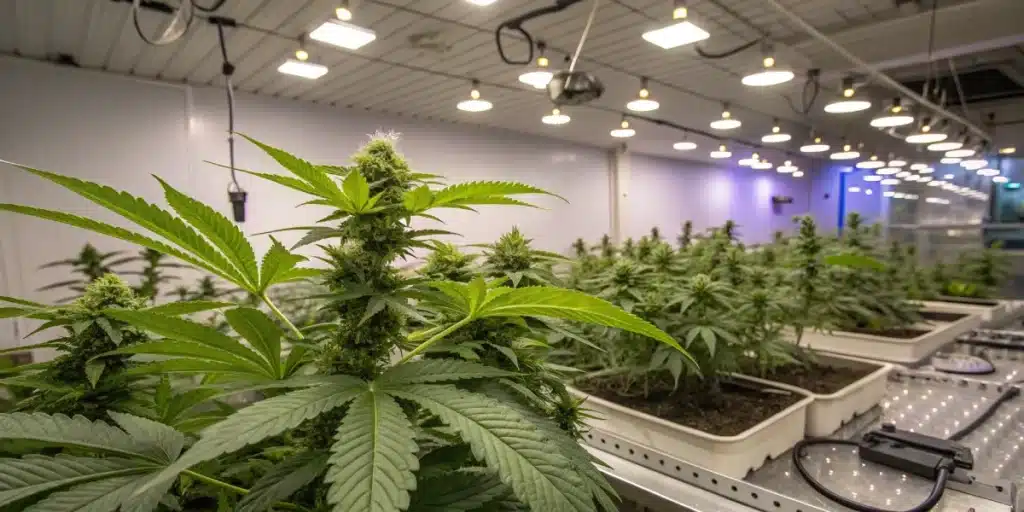
Managing Climate for Outdoor Sour Diesel in Canada
Managing the Canadian climate is one of the biggest challenges when growing Sour Diesel outdoors. Sour Diesel thrives in warm, sunny environments, which can be a bit tricky in some parts of Canada. However, with the right strategies, you can still achieve excellent results.
Dealing with Short Summers and Frost in Northern Canada
In northern parts of Canada, the growing season is short, and frost can arrive early in the fall. Sour Diesel’s long flowering period means that if frost hits before the plant has matured, your yield could be significantly reduced. To combat this, you might want to start your seeds indoors in early spring, giving them a head start before transplanting them outdoors once the risk of frost has passed.
If frost arrives earlier than expected, covering your plants with frost blankets or moving them to a sheltered location can protect them from the cold. Some growers even construct temporary greenhouses to extend the growing season. Planning for short summers and unpredictable frost is essential when growing Sour Diesel outdoors in Canada’s northern regions.
Maximizing Sunlight Exposure in Different Canadian Regions
Sunlight is a key factor in growing healthy Sour Diesel plants. In southern Canada, regions like British Columbia and Ontario offer longer days and more sunlight, which is ideal for outdoor cannabis cultivation. However, in other parts of Canada, shorter days during the growing season may limit your plants’ ability to fully mature.
To maximize sunlight exposure, plant your Sour Diesel in a spot that receives direct sunlight for most of the day. Avoid shaded areas, and if possible, position your plants to face south, ensuring they capture the most sunlight. For growers in regions with shorter daylight hours, consider supplementing with outdoor grow lights or moving your plants indoors as the days grow shorter. Maximizing sunlight exposure is a important part of growing Sour Diesel outdoors in Canada, especially in areas with limited daylight.
Rain, Humidity, and Temperature Control for Canadian Growers
Canada’s climate can be unpredictable, with rainstorms and high humidity posing challenges for outdoor growers. Sour Diesel, with its dense buds, is particularly susceptible to mold and mildew in humid conditions. To protect your plants, ensure good air circulation around them by spacing them properly and using fans if needed.
Additionally, using well-draining soil and containers with proper drainage can prevent root rot during periods of heavy rain. You may also need to set up rain covers or temporary greenhouses to shield your plants from excessive moisture. Temperature swings, especially between day and night, are another concern. While Sour Diesel can tolerate some fluctuations, dramatic temperature drops can stunt growth. Managing rain, humidity, and temperature is vital for growing Sour Diesel outdoors in Canada, especially in regions with unpredictable weather patterns.

Geographic Considerations
Canada’s vast geography means that the growing conditions for Sour Diesel can vary significantly depending on where you are. From the coastal climates of British Columbia to the cooler, drier regions of Alberta, each location presents its own unique challenges.
Coastal vs. Inland Growing in Canada
Coastal areas like British Columbia’s lower mainland enjoy milder temperatures and longer growing seasons, making them ideal for Sour Diesel cultivation. However, the high humidity in these areas can increase the risk of mold and mildew. Inland regions, such as Alberta and Manitoba, tend to have drier conditions, which can be beneficial in preventing mold but might require more frequent watering to keep the plants healthy.
Growers in coastal areas should focus on proper ventilation and air circulation to prevent moisture buildup, while inland growers should prioritize consistent watering schedules and monitoring for signs of drought stress. Tailoring your growing methods to your specific geographic location is essential when learning how to grow Sour Diesel outdoors in Canada.
Outdoor Growing: Adapting to South Africa’s Climate
While this article focuses on growing Sour Diesel in Canada, it’s worth noting that the techniques discussed here can also be adapted for outdoor growing in other parts of the world. South Africa, for example, has a climate that is similar in some ways to southern Canada, with long, sunny summers that are ideal for Sour Diesel. Understanding how to adapt to local conditions, whether in Canada or abroad, is key to successful outdoor cannabis cultivation.
Nutrient and Watering Needs for Sour Diesel in Canada
Getting the right balance of nutrients and water is key to growing Sour Diesel outdoors in Canada. This strain is a heavy feeder and requires consistent attention to ensure it receives everything it needs to thrive.
Organic vs. Synthetic Nutrients in Canadian Outdoor Grows
When it comes to feeding your Sour Diesel plants, you have two main options: organic or synthetic nutrients. Organic nutrients, such as compost, worm castings, and bat guano, are ideal for those who want to grow in a more environmentally friendly way. These natural fertilizers provide slow-release nutrients that help build healthy soil over time. Organic growing methods are often favored by those concerned with sustainability, and they can produce strong, flavorful buds.
On the other hand, synthetic fertilizers offer a more immediate boost, which can be useful for Sour Diesel’s fast growth demands. These fertilizers are often easier to manage, as they deliver precise amounts of nutrients, helping growers avoid deficiencies. However, synthetic nutrients can lead to nutrient burn if over-applied, so careful monitoring is necessary. Choosing between organic and synthetic nutrients depends on your growing style and environmental preferences when growing Sour Diesel outdoors in Canada.
Proper Watering Techniques in Canada’s Varying Climates
Watering Sour Diesel correctly is critical, especially when dealing with Canada’s varying climates. In wetter regions, overwatering can quickly lead to root problems, while in drier areas, you’ll need to water more frequently to prevent drought stress. The key is finding a balance.
For growers in rainy regions like the West Coast, focus on ensuring good drainage by using raised beds or containers with drainage holes. In drier areas like Alberta, mulching around your plants can help retain moisture and reduce the need for frequent watering. The goal is to water deeply but infrequently, encouraging the roots to grow deep and strong. Mastering the right watering techniques for your region is important to successfully growing Sour Diesel outdoors in Canada.
Addressing Nutrient Deficiencies in Canadian Soil
Depending on where you are in Canada, the natural soil may lack certain nutrients that Sour Diesel needs to thrive. If you notice yellowing leaves or slow growth, your plants might be suffering from a nutrient deficiency. Nitrogen, phosphorus, and potassium are the primary nutrients needed, but Sour Diesel also benefits from secondary nutrients like calcium and magnesium.
Testing your soil before planting is the best way to determine what nutrients may be lacking. Once you’ve identified deficiencies, you can amend the soil with the appropriate nutrients or fertilizers. Addressing nutrient deficiencies early on will ensure healthy growth throughout the growing season. Ensuring your plants have the proper nutrition is essential when growing Sour Diesel outdoors in Canada
Flowering and Harvesting Sour Diesel Outdoors in Canada
The flowering and harvesting stages are the most rewarding parts of growing Sour Diesel outdoors in Canada. As the plants reach their final stages of growth, proper care ensures a potent, high-yielding harvest. However, Canada’s short growing season requires careful timing and monitoring to maximize results.
Monitoring Flowering Times for Canada’s Short Growing Season
Sour Diesel’s long flowering time—between 10 and 12 weeks—can be a challenge in Canada’s outdoor environment. In most regions, the growing season ends by late September or early October, and if you don’t time your grow properly, you may face frost before the plants are ready to harvest. The key to success is monitoring your plants closely and making adjustments as necessary.
For growers in northern regions, starting your plants indoors can extend the growing season, allowing you to take advantage of the full summer months once transplanted outside. As your Sour Diesel plants enter the flowering stage, monitor the pistils and trichomes carefully. Sour Diesel’s buds are ready when the pistils turn from white to brownish-red and the trichomes become cloudy with a milky appearance. Timing this correctly ensures that your harvest will be potent and flavorful. By paying attention to flowering times, you can overcome the challenges of growing Sour Diesel outdoors in Canada.
When and How to Harvest Sour Diesel Before the Frost
Timing your harvest in Canada is key to avoid damage from early frost. Harvesting too early can result in lower potency, while waiting too long can expose your plants to frost, which can ruin the buds. The first frost typically hits northern Canada in late September or early October, while southern regions may have a few extra weeks.
To harvest Sour Diesel successfully, look for signs that the plant is ready, such as the change in trichomes and pistil color. Once these signs are visible, begin the harvesting process by cutting the plants in the morning when moisture levels are low. Be gentle when handling the buds, as Sour Diesel’s dense, resinous flowers can easily be damaged. If you expect frost before your plants are ready, consider using frost protection methods such as row covers or portable greenhouses. Timing your harvest correctly is critical for anyone growing Sour Diesel outdoors in Canada.
Post-Harvest Tips for Curing in Canadian Conditions
Once you’ve harvested your Sour Diesel plants, the work isn’t over. Proper curing is essential to ensure that your buds develop their full flavor and potency. In Canadian conditions, where the climate can be cool and dry, curing requires extra care to avoid overdrying or mold.
After harvesting, trim the buds and place them in a dark, cool area with temperatures between 18-22°C and humidity levels around 50%. You’ll want to dry the buds for about a week, ensuring there’s good air circulation to prevent mold. After drying, move the buds to airtight containers for curing. Open the containers daily for the first two weeks to allow excess moisture to escape. Proper curing can take anywhere from two weeks to a couple of months, but it’s worth the wait. This step brings out the best in your Sour Diesel, ensuring a smooth, flavorful smoke. Mastering the curing process is the final step in successfully growing Sour Diesel outdoors in Canada.
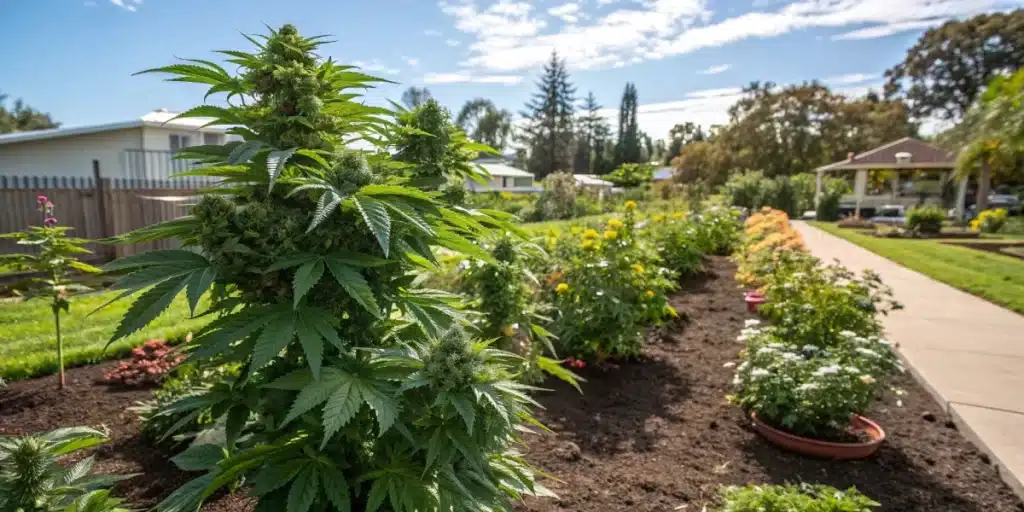
Week-by-Week Care for Sour Diesel in Canada
Growing Sour Diesel outdoors in Canada requires consistent, week-by-week care. Each phase of the plant’s life cycle demands attention to detail, particularly in Canada’s climate, where the weather can change quickly. By breaking down the growing process into weekly tasks, you’ll ensure your plants stay healthy and produce a high-quality yield.
Week 1-4: Germination and Early Vegetative Stage
During the first few weeks of growth, your Sour Diesel plants will focus on root and leaf development. In this stage, they need ample water and nutrients, particularly nitrogen. Start your seeds indoors if you live in a region with a shorter growing season, and transplant them outside once they’ve developed a few sets of true leaves. Make sure they’re planted in nutrient-rich soil and receive plenty of sunlight.
In these early weeks, monitor the soil moisture closely. Young plants are more vulnerable to overwatering or underwatering, so find the right balance by watering deeply but allowing the soil to dry out slightly between sessions. Proper care during the vegetative stage is important for growing Sour Diesel outdoors in Canada.
Week 5-8: Vegetative Growth
By the fifth week, your Sour Diesel plants should be well-established outdoors. In the vegetative stage, they’ll grow quickly, and you’ll need to feed them a nitrogen-rich fertilizer to support this rapid growth. Pruning or training techniques like topping or low-stress training (LST) can help improve light penetration and encourage more bud sites, leading to bigger yields.
Keep an eye on the weather during these weeks. In areas prone to heavy rainfall, make sure your plants have good drainage to avoid root rot. If temperatures drop unexpectedly, consider using row covers to protect your plants. Consistent care during this period will set the foundation for a healthy flowering stage, a key step in growing Sour Diesel outdoors in Canada.
Week 9-12: Flowering Begins
Around week nine, your plants will begin to show signs of flowering. At this point, switch to a fertilizer higher in phosphorus and potassium to support bud development. Sour Diesel requires a lot of energy during the flowering phase, so make sure your plants continue to get plenty of sunlight and water.
Check the weather regularly for signs of early frost or rainstorms, both of which can impact your yield. During the flowering phase, humidity control becomes even more important to prevent mold, especially in dense buds like those of Sour Diesel. Paying close attention to your plants during flowering is essential for a successful harvest when growing Sour Diesel outdoors in Canada.
Week 13-15: Final Flowering and Harvest Preparation
As your plants approach full maturity, their buds will continue to swell and become more resinous. By week 13, begin checking the trichomes daily for signs of ripeness. Once the trichomes are mostly cloudy with a few turning amber, it’s time to prepare for harvest.
During the final weeks, reduce watering to help concentrate the plant’s energy into the buds. If you’re expecting frost, consider harvesting slightly early to avoid losing your crop. Timing is key, especially in Canada’s unpredictable fall weather. Knowing when to harvest is critical for getting the most out of your Sour Diesel plants when growing outdoors.
FAQs
Can you grow Sour Diesel outdoors in Canada?
Yes, you can grow Sour Diesel outdoors in Canada, but it requires careful planning due to the country’s short growing season and unpredictable weather. Starting seeds indoors, selecting a sunny location, and protecting your plants from frost and wildlife are key strategies to succeed with this sativa-dominant strain in Canadian climates.
What is the best time to plant Sour Diesel outdoors in Canada?
The best time to plant Sour Diesel outdoors in Canada is after the last frost, typically in late May or early June depending on your region. Many growers start seeds indoors 3–4 weeks earlier to give their plants a head start before transplanting them outside.
How do I protect Sour Diesel plants from early frost in Canada?
To protect Sour Diesel from early frost, you can use row covers, frost blankets, or temporary greenhouses. If temperatures drop suddenly, consider moving container plants indoors or to a sheltered area. Starting your grow early indoors also helps ensure the plant finishes flowering before cold weather hits.



